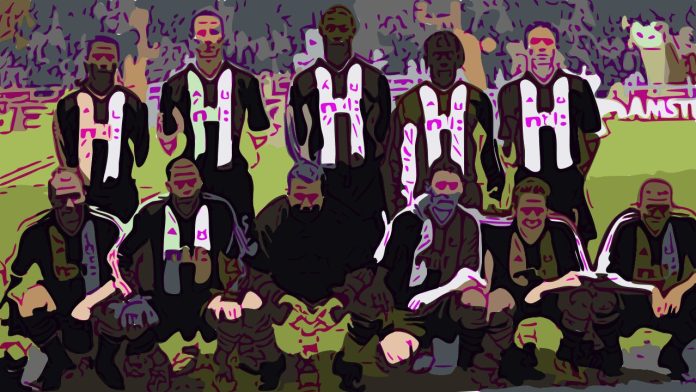When it comes to footballing combinations of flair, flamboyance and grit, it appears that the number three is the magic number. Attacking triumvirates have terrorized defenses down the years and their artistic brilliance combined with steely grit has got them etched into footballing folklore. From Brazil’s forward trio of the 1950s Ademir, Jair and Zizinho to The Holy Trinity of Manchester United (Sir Bobby Charlton, George Best and Denis Law) and current generation’s much-fabled MSN (Messi, Suarez and Neymar) and the BBC (Bale, Benzema and Cristiano Ronaldo) triumvirates have always held their own due to their sheer brilliance. Messi’s artistry combined so dangerously with Neymar’s flair and Suarez’s grit to frighten defenses for the better part of the last 5 years. The incomparable beauty of their football has left an indelible print on the beautiful game which remains to this day.
When one thinks of foursomes, it may look a little steep. Rather it looks a little unimaginative. From Arsenal’s famous back four of Tony Adams, Lee Dixon, Steve Bould and Nigel Winterburn to Sir Alex Ferguson’s midfield four which won them their treble Ryan Giggs, Paul Scholes, David Beckham and Roy Keane, basically these foursomes were known for their efficiency and not for their footballing genius. They were known for solidity and not necessarily brilliance. However each player mastered their roles perfectly, but Paul Scholes aside, there was a lack of artistic genius in these foursomes.
Every case has an exception and rightly so for this case the exception is the French midfield which shocked the world with their excellence in the mid-1980s. The midfield of Luis Fernandez, Jean Tigana, Alain Giresse and the iconic Michael Platini (popularly called Le Carre Magique(The Magic Square)) demonstrated to the world what can happen when exceptional talents come together. The brilliance of the quartet was characterized by their invention, industry, creativity and cohesion. They managed to lead France to the 1984 UEFA European Championships and announced France’s re-entry as a footballing power after the disastrous performances of the previous decade. The quartet combined beauty and elegance with teamwork to mark their name on the footballing world.

It all started after France had bowed out of the 1982 World Cup after losing to West Germany in a match fondly remembered for Harold Schumacher’s inhumane tackle on Patrick Battiston which apparently missed the referee’s sight, thereby going unnoticed. After the exit, the French team’s performances weren’t too good and by this time all the four (Platini, Giresse, Tigana and Luis Fernandez) had been called up to the national team but hadn’t played together as a unit but had played as duos and trios.
Prior to the 1984 UEFA European Championships France coach Michael Hidalgo decided to experiment with all the four playing in midfield forming a square rather than a conventional diamond. When all the four played their first game against Bobby Robson’s England, Luis Fernandez was 24, Alain Giresse 31 and the other two (Tigana and Platini) were 28. The quartet quickly became the neutral’s favourites as they moved the ball around casually with serenity that almost looked like it bordered on laziness; casual arrogance, if you would have it that way.
Due to hosting the event France had the privilege of qualifying directly. Coach Michel Hidalgo had moulded his team through friendlies that yielded 12 wins from 13. Consequently optimism was soaring and the general feeling amidst the public was that Les Bleus might exorcise the pain from their World Cup semi-final exit to Germany in ’82 following a thrilling 3-3 draw and defeat on pens. Defender Patrick Battison certainly had motivation for going all the way this time after recovering from a scandalous, unpunished assault by German keeper Schumacher that sent him staggering into a coma.
France in Euro 84 and World Cup 86
France powered their way to winning the much-coveted Henri Delaunay trophy, a trophy they had gifted to the world of football. Michael Platini was undoubtedly the star of the tournament as he scored in every game on course to victory. France won their first game 1-0 against Denmark courtesy of a Platini strike. Platini scored a stunning hat-trick in the following game to hand France a 5-0 win over Belgium, the other two goals being scored by Giresse and Fernandez. In the final group stage game Platini scored another treble as he outscored Yugoslavia 3-2. France needed extra time to get past Portugal with Platini scoring the decisive winner in the final minutes of a match following a run into the box by the marauding Jean Tigana. In the final against Spain, France took the lead in the second half through a Michel Platini freekick. A late goal by Bruno Bellion gave France a 2-0 win and also their first-ever international trophy.
By the start of 1986, France were placed on the top of Elo ratings and also labelled as bookmakers’ favourite to win the World Cup. France passed through the group stages and faced Italy, the defending champions in the round of 16. France won 2-0 after goals from Michel Platini and Dominique Rocheateu. In the quarterfinals France faced Brazil. Careca opened the scoring for Brazil before Platini equalized for France. Both teams failed to break the deadlock and the game went to penalties. France won 4-3 on penalties with Luis Fernandez scoring a memorable winning penalty. After this game Brazilian greats Socrates and Zico announced their retirement from international football. In the semifinals, France once again faced West Germany in a rematch of the 1982 semifinals. The Germans ended up winners after goals from Andreas Brehme and Rudi Voller. France won the third-place game against Belgium after which Giresse retired from international duty.
France and the magic square
Spanish born Luis Fernandez was placed at the bottom of the square to provide cover and industry to Alain Giresse and Jean Tigana who were placed in the left and right respectively. Platini was given a free role at the top of the square to plunder and wreak havoc behind the forwards.
Luis Fernandez brought a combative element to the team as well as rejuvenating a side lacking in youth. He added greater balance to the square that had looked lopsided beforehand. He bossed each game with sophisticated charm. He added steel to the back four and was also the link between the defence and the attack. His industry and bite made him a prototype, a model midfielder and a vital midfield general. He was crucial in freeing up space for the Giresse and Platini to move forward and work the space. Despite his ruggedness, he was more than just a midfield destroyer, he possessed a delightful touch, accuracy and a panoramic vision in reading the game. He was the final piece of the puzzle to the Magic Square.
Alain Giresse was a perfect example of how one can overcome physical shortcomings with technical brilliance. Standing at 5 feet and 4 inches, the diminutive wizard was a master when he had the ball at his feet. The incisive passing and ball retention which Giresse possessed were an integral part of the French game, while his low centre of gravity allowed him to skip past opposing challenges with typical Gallic flair. Giresse floated around linking attacks with one-touch ease. His slight stature also belied an impressive work-rate and an unquenchable desire to win possession.
Jean Tigana was the engine of the side. Every movement he made appeared to be at pace, surging forward and driving the team from the heart of midfield. In the modern game no one comes close to matching the dynamism that Tigana embodied. Yet to focus solely on his physical attributes is to ignore the subtlety of passing and touch that Tigana demonstrated. Tigana was more than just an athlete, he was a complete footballer, comfortable and confident in multiple situations.
Undeniably the greatest individual of the quartet was Michel Platini. A prodigious talent, he strolled around the midfield with the air of a French cavalry officer, splitting defenses at will with his vision and astounding range of passing. Platini was the playmaker, orchestrator and brain of the team. Arguably his finest attribute (yes, even better than those free-kicks) was an ability to find space in the most congested of midfields and he used every inch he found to devastating effect. Initial doubts about the strength of his heart as an adolescent were ironic, given the vigour with which he led France. Even in a midfield this talented, it was only natural that the rest would defer to his genius. As the focal point in a fluid, innovative midfield that was talented, it still stands testament to Platini’s brilliance that they could not match what Platini could do on the ball. He made a name for himself as a midfield maestro in an era of Diego Maradona, Zico and Socrates.
The ’84 Euros coincided with his talent hitting its absolute zenith; a Ballon D’Or recipient and a future World Player of the Year and a European Cup winner with Juventus, at 29 Le Roi (as Platini was fondly called) was ready to rule and quite simply he tore the tournament apart scoring nine goals in the five games that led to the trophy being raised aloft to a jubilant nation.
France’s triumph was one founded on the collective, a well organised and well-rounded team which had a wonderful understanding of how their style of play fitted together. As Alain Giresse reflected on quite what made the quartet so special: “It was a complementary midfield, with players who knew how to work, build, distribute, finish. And we liked having the ball.” Few will ever forget how Le Carré Magique set the summer of 1984 alight.
Yet even among a midfield (and the team as a whole) which was full of excellent players, one man stood out; Platini. When we remember the great individuals at great tournaments, thoughts so often centre on the World Cups of Garrincha in 1962, Pelé in 1970 and Maradona in 1986, but Platini’s 1984 stands comparison with any of them. 9 goals in 5 games tell a part of the story, but even that astonishing statistic (the next highest scorers in the tournament managed just 2) sells him short.
After scoring the winner against Portugal in the semifinals of the 1984 Euros, Platini released himself from the engulfment of delirious teammates, as he held his hands out flat for the orchestrator of the move to slap. Instead, Jean Tigana collapsed tired into his arms resulting in the merging of two corners to form a magical square.


